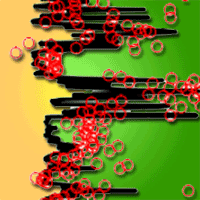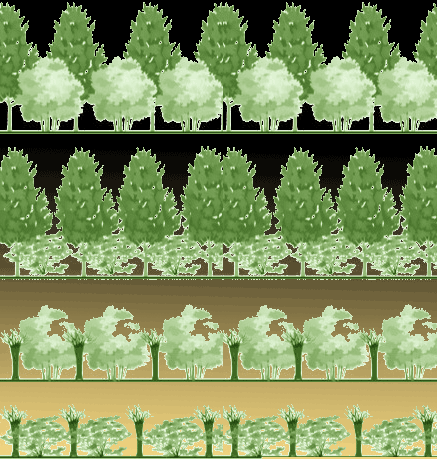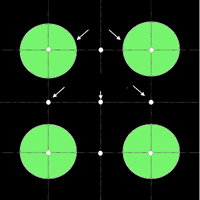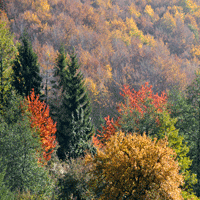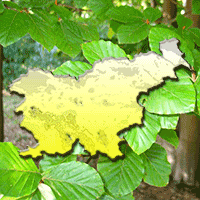Forests dominated by black alder (Alnus glutinosa) potentially support habitats with high biological diversity, including rare and endangered species with specific demands for the habitat. However, the knowledge on the response of set-aside black alder forests to adjacent stand management is still insufficient for planning sustainable forest management and requires additional studies on the dynamics of complex organism groups. We conducted repeated inventories of ground vegetation, epiphytic lichens, polypores, and mollusks in the periphery and interior of 10 set-aside black alder-dominated forest stands in Latvia over seven years after adjacent forest management, to determine the response of these organism groups. Our results showed that the diversity of the studied organism groups either remained unchanged or increased from 2004 to 2011. The volume of dead wood increased significantly in all studied plots and correlated positively with polypore abundance and species diversity. We observed an increase in mollusk species number in the stand interior, but not in the periphery plots. No significant spatial differences in forest stand parameters or species diversity were found between stand interior and periphery plots in either the first or the second survey. The obtained results suggested that the 60-meter periphery zone was able to maintain species richness and diversity similar to the interior, highlighting the importance of black alder-dominated forests in supporting species diversity across the studied organism groups.
Keywords
, , , , ,
Citation
Donis J, Pentjuša L, Gerra-Inohosa L, Zdors L, Bambe B, Meiere D, Pilate D, Straupe I, Jansons A, Libiete Z (2025). Conservation values in set-aside black alder forests adjacent to managed stands: short-term changes. iForest 18: 319-326. - doi: 10.3832/ifor4782-018
Academic Editor
Michele Carbognani
Paper history
Received: Dec 27, 2024
Accepted: May 31, 2025
First online: Nov 03, 2025
Publication Date: Dec 31, 2025
Publication Time: 5.20 months
© SISEF - The Italian Society of Silviculture and Forest Ecology 2025
Open Access
This article is distributed under the terms of the Creative Commons Attribution-Non Commercial 4.0 International (https://creativecommons.org/licenses/by-nc/4.0/), which permits unrestricted use, distribution, and reproduction in any medium, provided you give appropriate credit to the original author(s) and the source, provide a link to the Creative Commons license, and indicate if changes were made.

Breakdown by View Type
(Waiting for server response...)
Article Usage
Total Article Views: 1027
(from publication date up to now)
Breakdown by View Type
HTML Page Views: 253
Abstract Page Views: 453
PDF Downloads: 292
Citation/Reference Downloads: 0
XML Downloads: 29
Web Metrics
Days since publication: 47
Overall contacts: 1027
Avg. contacts per week: 152.96
Article Citations
Article citations are based on data periodically collected from the Clarivate Web of Science web site
(last update: Mar 2025)
(No citations were found up to date. Please come back later)
Publication Metrics
by Dimensions ©
Articles citing this article
List of the papers citing this article based on CrossRef Cited-by.
(1)
Alexander K, Butler J, Green T (2006)The value of different tree and shrub species to wildlife. British Wildlife 18 (1): 18-28.
Gscholar
(2)
Aragón G, Abuja L, Belinchón R, Martínez I (2015)Edge type determines the intensity of forest edge effect on epiphytic communities. European Journal of Forest Research 134: 443-451.
CrossRef |
Gscholar
(3)
Auninš A (2013)Eiropas Savienibas Aizsargajamie biotopi Latvija. Noteikšanas rokasgramata. 2. Precizetais izdevums [European Union Protected Habitats in Latvia. Interpretation Manual]. Latvijas Dabas fonds, Vides aizsardzibas un regionalas attistibas ministrija, Riga, Latvija, pp. 320. [in Latvian]
Gscholar
(4)
Boddy L, Büntgen U, Egli S, Gange AC, Heegaard E, Kirk PM, Mohammad A, Kauserud H (2014)Climate variation effects on fungal fruiting. Fungal Ecology 10: 20-33.
CrossRef |
Gscholar
(5)
Boeraeve M, Honnay O, Jacquemyn H (2019)Forest edge effects on the mycorrhizal communities of the dual-mycorrhizal tree species
Alnus glutinosa (L.) Gaertn. Science of the Total Environment 666: 703-712.
CrossRef |
Gscholar
(6)
Chen J, Saunders SC, Crow TR, Naiman RJ, Kimebrley D, Brosofske D, Mroz GD, Brookshire BL, Franklin JF (1999)Microclimate in forest ecosystem and landscape ecology: variations in local climate can be used to monitor and compare the effects of different management regimes. Bioscience 49 (4): 288-297.
CrossRef |
Gscholar
(7)
Cejka T, Hamerlik L (2009)Land snails as indicators of soil humidity in Danubian woodland (SW Slovakia). Polish Journal of Ecology 57 (4): 741-747.
Online |
Gscholar
(8)
Council Directive (1992)Council Directive 92/43/ EEC of 21 May 1992 on the conservation of natural habitats and of wild fauna and flora. Official Journal of the European Union 206 (7), pp. 7-50.
Online |
Gscholar
(9)
Donis J, Bambe B, Barševskis A, Meiere D, Pilate D, Piterans A, Straupe I (2004)Dabisko meža biotopu monitoringa metodikas izstrade un aprobacija [Development and approbation of the monitoring method of Woodland key habitats management]. LVMI “Silava”, Salaspils, Latvia, pp. 70 [in Latvian]
Gscholar
(10)
Donis J, Kitenberga M, Snepsts G, Dubrovskis E, Jansons A (2005)Factors affecting windstorm damage at the stand level in hemiboreal forests in Latvia: case study of 2005 winter storm. Silva Fennica 52 (4): 10009.
CrossRef |
Gscholar
(11)
Douda J, Boublík K, Slezák M, Biurrun I, Nociar J, Havrdová A, Zimmermann NE (2016)Vegetation classification and biogeography of European floodplain forests and alder carrs. Applied Vegetation Science 19 (1): 147-163.
CrossRef |
Gscholar
(12)
Dovčiak M, Brown J (2014)Secondary edge effects in regenerating forest landscapes: vegetation and microclimate patterns and their implications for management and conservation. New Forests 45: 733-744.
CrossRef |
Gscholar
(13)
Duguid MC, Ashton MS (2013)A meta-analysis of the effect of forest management for timber on understory plant species diversity in temperate forests. Forest Ecology and Management 303: 81-90.
CrossRef |
Gscholar
(14)
Ek T, Suško U, Auzinš R (2002)Mežaudžu atslegas biotopu inventarizacijas metodika [Methodology of woodland key habitat inventory]. Valsts meža dienests, Riga, Latvija, pp. 76. [in Latvian]
Gscholar
(15)
Eldegard K, Totland Ø, Moe SR (2015)Edge effects on plant communities along power line clearings. Journal of Applied Ecology 52 (4): 871-880.
CrossRef |
Gscholar
(16)
Esseen PA, Hedström Ringvall A, Harper KA, Christensen P, Svensson J (2016)Factors driving structure of natural and anthropogenic forest edges from temperate to boreal ecosystems. Journal of Vegetation Science 27 (3): 482-492.
CrossRef |
Gscholar
(17)
Esseen PA, Renhorn KE (1998)Edge effects on an epiphytic lichen in fragmented forests. Conservation Biology 12 (6): 1307-1317.
CrossRef |
Gscholar
(18)
Gavrilova G, Sulcs V (1999)Flora of Latvian vascular plants: list of taxa. Institute of Biology of University of Latvia, Riga, Latvia, pp. 1-136.
Gscholar
(19)
Gheoca V, Benedek AM, Schneider E (2021)Exploring land snails’ response to habitat characteristics and their potential as bioindicators of riparian forest quality. Ecological Indicators 132: 108289.
CrossRef |
Gscholar
(20)
Glöer P, Meier-Brook C (2003)Süßwassermollusken. Ein Bestimmungsschlüssel für die Bundesrepublik Deutschland. 13. neubearbeitete Auflage [Freshwater Molluscs: an identification key for the Federal Republic of Germany. 13th revised edition]. Deutscher Jugendbund für Naturbeobachtung, Hamburg, Germany, pp. 134.
Gscholar
(21)
Green P, Peterken GF (1997)Variation in the amount of dead wood in the woodlands of the Lower Wye Valley, UK in relation to the intensity of management. Forest Ecology and Management 98 (3): 229-238.
CrossRef |
Gscholar
(22)
Harper KA, Macdonald SE, Burton PJ, Chen J, Brosofske KD, Saunders SC, Euskirchen ES, Roberts DAR, Jaiteh MS, Esseen PA (2005)Edge influence on forest structure and composition in fragmented landscapes. Conservation Biology 19 (3): 768-782.
CrossRef |
Gscholar
(23)
Hylander K, Nilsson C, Göthner T (2004)Effects of buffer-strip retention and clearcutting on land snails in boreal riparian forests. Conservation Biology 18 (4): 1052-1062.
CrossRef |
Gscholar
(24)
Horáčková J, Horsák M, Juričková L (2014)Land snail diversity and composition in relation to ecological variations in Central European floodplain forests and their history. Community Ecology 15: 44-53.
CrossRef |
Gscholar
(25)
Hottola J, Siitonen J (2008)Significance of wooland key habitats for polypore diversity and red-listed species in boreal forests. Biodiversity and Conservation 17 (11): 2559-2577.
CrossRef |
Gscholar
(26)
Hrivnák R, Svitok M, Hegedüšová Vantarová K, Jarolímek I, Kochjarová J, Májeková J, Slezák M (2024)Environmental thresholds for plant species richness of black alder (
Alnus glutinosa) forests in Central Europe. Wetlands Ecology and Management 32: 591-604.
CrossRef |
Gscholar
(27)
Ylisirniö AL, Mönkkönen M, Hallikainen V, Ranta-Maunus T, Kouki J (2016)Woodland key habitats in preserving polypore diversity in boreal forests: effects of patch size, stand structure and microclimate. Forest Ecology and Management 373: 138-148.
CrossRef |
Gscholar
(28)
Jönsson MT, Jonsson BG (2007)Assessing coarse woody debris in Swedish woodland key habitats: implications for conservation and management. Forest Ecology and Management 242 (2-3): 363-373.
CrossRef |
Gscholar
(29)
Jüriado I, Paal J (2003)Epiphytic and epixylic lichen species diversity in Estonian natural forests. Biodiversity and Conservation 12: 1587-1607.
CrossRef |
Gscholar
(30)
Kerney MP, Cameron RAD, Jungbluth JH (1983)Die Landschnecken Nord- und Mitteleuropas [The land snails of Northern and Central Europe]. Paul Parey, Hamburg, Germany, pp. 384. [in German]
Gscholar
(31)
Király I, Nascimbene J, Tinya F, Odor P (2013)Factors influencing epiphytic bryophyte and lichen species richness at different spatial scales in managed temperate forests. Biodiversity and Conservation 22: 209-223.
CrossRef |
Gscholar
(32)
Koelemeijer IA, Ehrlén J, Jönsson M, De Frenne P, Berg P, Andersson J, Weibull H, Hylander K (2022)Interactive effects of drought and edge exposure on old-growth forest understory species. Landscape Ecology 37 (7): 1839-1853.
CrossRef |
Gscholar
(33)
Lõhmus A, Kraut A (2010)Stand structure of hemiboreal old-growth forests: characteristic features, variation among site types, and a comparison with FSC-certified mature stands in Estonia. Forest Ecology and Management 260 (1): 155-165.
CrossRef |
Gscholar
(34)
Madzule L, Brumelis G, Terauds A, Zarinš J (2012)Time needed to achieve sufficient richness of structural elements and bryophytes in deciduous forest stands. Environmental and Experimental Biology 10: 57-66.
Online |
Gscholar
(35)
Murcia C (1995)Edge effects in fragmented forests: implications for conservation. Trends in Ecology and Evolution 10 (2): 58-62.
CrossRef |
Gscholar
(36)
Mullu D (2016)A review on the effect of habitat fragmentation on ecosystem. Journal of Natural Sciences Research 6 (15): 1-15.
Online |
Gscholar
(37)
Nascimbene J, Thor G, Nimis PL (2013)Effects of forest management on epiphytic lichens in temperate deciduous forests of Europe - a review. Forest Ecology and Management 298: 27-38.
CrossRef |
Gscholar
(38)
Odor P, Király I, Tinya F, Bortignon F, Nascimbene J (2013)Patterns and drivers of species composition of epiphytic bryophytes and lichens in managed temperate forests. Forest Ecology and Management 306: 256-265.
CrossRef |
Gscholar
(39)
Oettel J, Lapin K (2021)Linking forest management and biodiversity indicators to strengthen sustainable forest management in Europe. Ecological Indicators 122: 107275.
CrossRef |
Gscholar
(40)
Peltoniemi M, Penttilä R, Mäkipää R (2013)Temporal variation of polypore diversity based on modelled dead wood dynamics in managed and natural Norway spruce forests. Forest Ecology and Management 310: 523-530.
CrossRef |
Gscholar
(41)
Pilate D (2009)Structure of terrestrial snail communities of Euro-Siberian alder swamps (Cl.
Alnetea glutinosae) in Latvia. Acta Zoologica Lituanica 19 (4): 297-305.
CrossRef |
Gscholar
(42)
Piterans A (2001)Latvijas kerpju konspekts [Overview of lichens in Latvia]. Latvijas Vegetacija 3: 5-46. [in Latvian]
Gscholar
(43)
Pöpperl F, Rupert S (2021)Effects of stand edges on the structure, functioning, and diversity of a temperate mountain forest landscape. Ecosphere 12 (8): e03692.
CrossRef |
Gscholar
(44)
Prieditis N (1997)Alnus glutinosa-dominated wetland forests of the Baltic Region: community structure, syntaxonomy and conservation. Plant Ecology 129 (1): 49-94.
CrossRef |
Gscholar
(45)
R Core Team (2021)R: a language and environment for statistical computing. Vienna, R Foundation for Statistical Computing. Available at.
Online |
Gscholar
(46)
Ryvarden L, Gilbertson RL (1993)European Polypores. Fungiflora, Oslo, Norway, pp. 745.
Online |
Gscholar
(47)
Rudzite M, Dreijers E, Ozolina-Molla L, Pilate D, Rudzitis M, Stalas A (2010)A guide to the molluscs of Latvia. LU Akademiskais apgads, Riga, Latvia, pp. 252.
Gscholar
(48)
Sippola AL, Renvall P (1999)Wood-decomposing fungi and seed-tree cutting: a 40-year perspective. Forest Ecology and Management 115 (2-3): 183-201.
CrossRef |
Gscholar
(49)
Sitzia T, Campagnaro T, Dainese M, Cassol M, Dal Cortivo M, Gatti E, Padovan F, Sommacal M, Nascimbene J (2017)Contrasting multi-taxa diversity patterns between abandoned and non-intensively managed forests in the southern Dolomites. iForest 10 (5): 845-850.
CrossRef |
Gscholar
(50)
Stokland JN, Siitonen J, Jonsson BG (2012)Biodiversity in dead wood. Cambridge University Press, Cambridge, UK, pp. 509.
Gscholar
(51)
Straupe I, Donis J (2006)The lichenoindicative evaluation of pine natural woodland habitats. In: International Scientific Conference Proceedings. Jelgava (Latvia) 19-22 May 2006. Latvia University of Agriculture, Jelgava, Latvia, pp. 276-283.
Gscholar
(52)
Timonen J, Gustafsson L, Kotiaho JS, Mönkkönen M (2011)Hotspots in cold climate: conservation value of woodland key habitats in boreal forests. Biological Conservation 144 (8): 2061-2067.
CrossRef |
Gscholar
(53)
Vanneste T, Depauw L, De Lombaerde E, Meeusen C, Govaert S, De Pauw K, Sanczuk P, Bollmann K, Brunet J, Calders K, Cousins SAO, Diekmann M, Gasperini C, Graae BJ, Hedwall P-O, Iacopetti G, Lenoir J, Lindmo S, Orczewska A, Ponette Q, Plue J, Selvi F, Spicher F, Verbeeck H, Zellweger F, Verheyen K, Vangansbeke P, De Frenne P (2024)Trade-offs in biodiversity and ecosystem services between edges and interiors in European forests. Nature Ecology and Evolution 8 (5): 880-887.
CrossRef |
Gscholar



